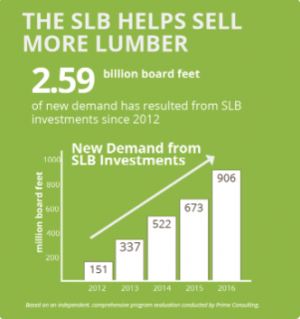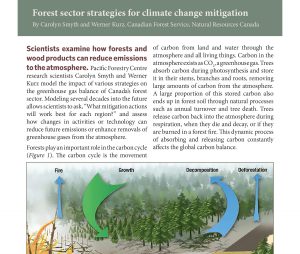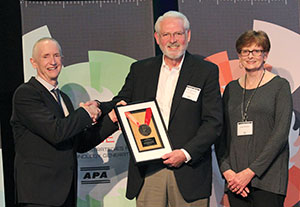Paper Advance sat down with Mr. Stéphane Renou, President and Chief Executive Officer of FPInnovations, to discuss his new role. Below are a few quotes from his response:
- The forestry sector is at a critical juncture: there’s a thirst for innovation now more than ever. Developing innovation requires the desire to inno- vate along with an open mind to acquire new approaches from other industries and apply them in the forestry context to advance its particular needs.
- Over the next year, we will work closer with all our partners, improve efficiency and improve value creation as highlighted during the recent survey that FPInnovations launched in 2017.
- FPInnovations is evolving and increasing its focus on developing the best innovation value proposition for the forest-based industry. We all need to evolve more rapidly to support a constantly changing world and its needs. This can only be achieved through collaboration within and outside of the industry.


 Lumber is an integral part of your business and how America builds its housing. The Softwood Lumber Board’s (SLB’s) mission is to make it much more than that. Our unique programs are showing what is possible when building with wood across residential, commercial, mid-rise, appearance, and even tall building segments. …So far since 2012, our investments have resulted in 2.59 billion board feet of new demand—reflecting a fivefold increase through 2016.
Lumber is an integral part of your business and how America builds its housing. The Softwood Lumber Board’s (SLB’s) mission is to make it much more than that. Our unique programs are showing what is possible when building with wood across residential, commercial, mid-rise, appearance, and even tall building segments. …So far since 2012, our investments have resulted in 2.59 billion board feet of new demand—reflecting a fivefold increase through 2016. 
 Scientists examine how forests and wood products can reduce emissions to the atmosphere. Pacific Forestry Centre research scientists Carolyn Smyth and Werner Kurz model the impact of various strategies on the greenhouse gas balance of Canada’s forest sector. Modeling several decades into the future allows scientists to ask, “What mitigation actions will work best for each region?” and assess how changes in activities or technology can reduce future emissions or enhance removals of greenhouse gases from the atmosphere. Forests play an important role in the carbon cycle. The carbon cycle is the movement of carbon from land and water through the atmosphere and all living things. …This dynamic process of absorbing and releasing carbon constantly affects the global carbon balance.
Scientists examine how forests and wood products can reduce emissions to the atmosphere. Pacific Forestry Centre research scientists Carolyn Smyth and Werner Kurz model the impact of various strategies on the greenhouse gas balance of Canada’s forest sector. Modeling several decades into the future allows scientists to ask, “What mitigation actions will work best for each region?” and assess how changes in activities or technology can reduce future emissions or enhance removals of greenhouse gases from the atmosphere. Forests play an important role in the carbon cycle. The carbon cycle is the movement of carbon from land and water through the atmosphere and all living things. …This dynamic process of absorbing and releasing carbon constantly affects the global carbon balance. Plant diseases threaten many of Canada’s most important timber crops and tree species. Over the years forest pathologists from Mexico to Alaska have worked together to develop important knowledge on how to manage North American forest diseases. Experts work across borders to discuss climate change, mistletoe, foliage and twig diseases, hazard trees, nursery disease, root disease and rusts. Like people, plants catch viruses too. Blueberry Scorch Virus infects our blueberry crops in BC, and infected plants su er with sluggish growth that reduces yields. Another example is Blister Rust of white pine trees; this fungal disease severely a ects this tree’s survival. Pathologists use a range of tools to combat these diseases, but not creating the conditions for them to ourish is one of the most important steps.
Plant diseases threaten many of Canada’s most important timber crops and tree species. Over the years forest pathologists from Mexico to Alaska have worked together to develop important knowledge on how to manage North American forest diseases. Experts work across borders to discuss climate change, mistletoe, foliage and twig diseases, hazard trees, nursery disease, root disease and rusts. Like people, plants catch viruses too. Blueberry Scorch Virus infects our blueberry crops in BC, and infected plants su er with sluggish growth that reduces yields. Another example is Blister Rust of white pine trees; this fungal disease severely a ects this tree’s survival. Pathologists use a range of tools to combat these diseases, but not creating the conditions for them to ourish is one of the most important steps.
 Yukon is home to extensive boreal forest that covers an area of approximately 28.1 million hectares (ha) and plays an integral role in the regulation of climate locally, regionally and internationally. Yukon’s forests contribute to the territory’s economy by providing wood and other forest products, local employment, regional development, tourism and recreational opportunities in addition to being valued as a vital cultural, social, historical and educational resource. …Boreal ecosystems are especially vulnerable to climate change. Melting permafrost, increased severity of insect outbreaks and drought are driving major forest changes …Potential exists for rapid ecosystem transitions, with parts of the boreal forest nearing ecological “tipping points” by the end of the century. Scientists are already beginning to see evidence of climate associated declines of spruce, pine and aspen in some parts of the boreal forest.
Yukon is home to extensive boreal forest that covers an area of approximately 28.1 million hectares (ha) and plays an integral role in the regulation of climate locally, regionally and internationally. Yukon’s forests contribute to the territory’s economy by providing wood and other forest products, local employment, regional development, tourism and recreational opportunities in addition to being valued as a vital cultural, social, historical and educational resource. …Boreal ecosystems are especially vulnerable to climate change. Melting permafrost, increased severity of insect outbreaks and drought are driving major forest changes …Potential exists for rapid ecosystem transitions, with parts of the boreal forest nearing ecological “tipping points” by the end of the century. Scientists are already beginning to see evidence of climate associated declines of spruce, pine and aspen in some parts of the boreal forest. 
